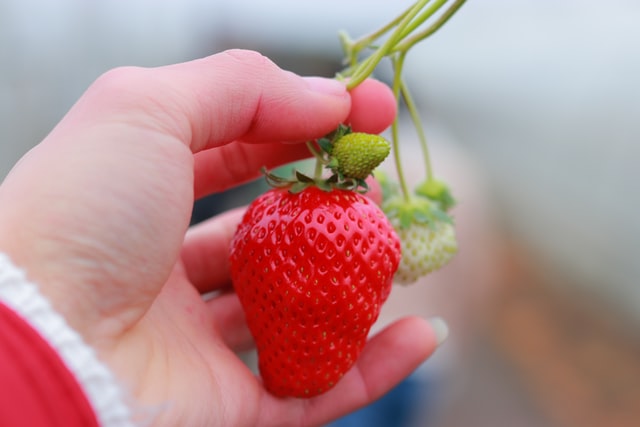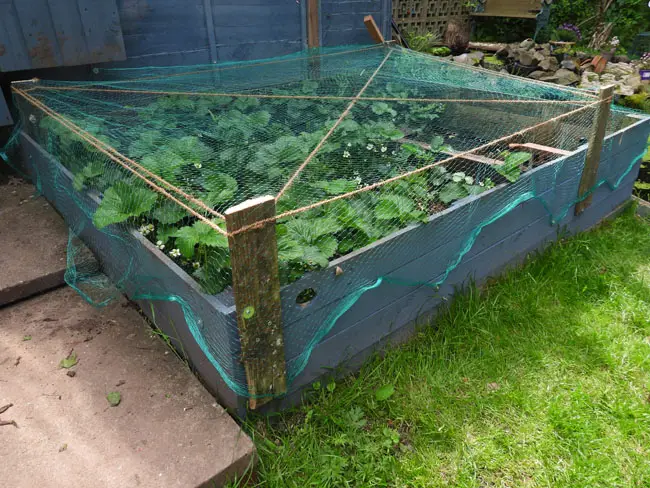Strawberries are a fabulous addition to the garden and they are an excellent choice for an easier fruit to grow. Despite this, you do need to consider some strawberry protection. That’s because us humans aren’t the only ones who think the berries are delicious!

Strawberries are iconic summer fruits that are so enjoyable on those warm sunny days. Picnics, Wimbledon, smoothies, jam, picking your own – strawberries have so many connections and memories around those seasonal months.
Having strawberries growing at your fingertips is so fruitful, pardon the pun! Of course, humans aren’t alone in enjoying the juicy flavours of strawberries and having them in your garden can encourage their fan club. Birds, squirrels, and mice are just a few of the animals who will happily tuck into the flowers and fruit. It can be very soul destroying watching your plants grow, then to be eaten without getting to enjoy the results.
Don’t fret though – strawberry protection is easy when using the correct fruit netting, frames or cages.
Our guide will provide you with all the information you require to protect your strawberry plants and enjoy growing them for years to come.
Jump To...
Common Strawberry Pests and Problems
Like with most things you grow in your garden, strawberries will always have the potential to attract pests.
However, with some careful thought and planning, you can create a safe space for your fruit plants to flourish. Even better, you can still allow enough room for bees and other pollinators to get in.
Top 5 Reasons for Strawberry Protection
- Wood Pigeons: Notoriously greedy birds, wood pigeons are very much opportunists. If food is there to eat, they will happily eat most things, including strawberry plants. Eating the plants will affect the size of the crop so they ideally need protection right from the beginning.
- Squirrels: Like other garden visitors, squirrels like to find food while it is around. They know that food is scarcer in winter. With this in mind, they will eat and cache strawberries. Popping on a net or cage won’t necessarily stop them altogether as they are very determined creatures. However, it will slow them down and you can make modifications to the design if this is necessary.
- Badgers: These animals are natural foragers. Badgers spend large parts of their evening with their noses to the ground looking for worms. They will dig and forage, maybe even eat, in the strawberry patch. This means a fruit cage would stop them from being able to access them.
- Deer: Now, let’s be honest, how lovely it is to have these lovely visitors in your garden! Deer taking up residence in gardens has become increasingly common now that so many green spaces are being built up. As lovely as they are though, they too need to eat and will happily feast on strawberry plants given the opportunity.
- Insects: You will need a specific type of protection if you wish to keep out insects such as aphids. Again though, with the right research, you can offer protection for your plants which can deter all sorts of problematic pests. Insects can destroy the fruit by eating their way through or by causing bacteria to spread.
How to Protect Strawberries from…
Slugs, squirrels, birds, bugs
The pest you are trying to protect your strawberries from can vary in size quite dramatically. From tiny bugs to squirrels or even bigger!
This is why there are different options for you when it comes to purchasing strawberry netting and strawberry cages. It isn’t a one size fits all scenario – you will need to research exactly what you need.
Birds can be deterred by simple netting. You need to ensure it is kept taut to stop them from getting caught, but other pests may need a more robust option.
What Types of Strawberry Protection Can You Use?
There are many options for strawberry protection so it’s really about understanding what you wish to protect your fruit from.
If you get the occasional pigeon then your solution may be different from someone with a garden teeming with wildlife.
Strawberry Netting
The cheapest option for sure, strawberry netting will do the job in many instances. Some simple mesh can offer a lot of protection for your strawberries.
It will discourage big and small birds from feeding on the plants and fruit itself which can be a huge problem for strawberry growers.
Going down this route will require a few considerations though, such as making sure birds do not get tangled in the netting.
Choose the hole size carefully and be sure the netting is taut at all times. You will want to consider pollinators being able to get through too. The net will need to be higher than the plants so as not to squash them, hindering their growth.
- Best Feature: A low-cost idea that can be constructed by recycling wood from around your garden.
- Things To Consider: You will need some DIY skills to put this together and be careful when choosing hole size.
Strawberry Frames
Frames are often used together with netting, so if you have settled on this option, your next consideration will be a straberry frame.
The frame will hold the netting in place and you can either build one from some wood or purchase a frame to suit your needs.
If the thought of making one doesn’t appeal, you can instead measure the area required for covering and purchase one. They come in a range of materials including; aluminium, wooden, plastic, and steel so there are varying levels of sturdiness.
- Best Feature: Framing can be made from old materials.
- Things to Consider: Plastic frames can be cheaper but will not last indefinitely like more robust materials.
Strawberry Cages
A strawberry cage doesn’t have to be expensive, you can enjoy protection from pests on a budget. Our step by step guide shows you how!
How To Make A DIY Strawberry Netting Cage On A Budget …
- Measure the area you want to protect so that you know how much netting and would you will require.
- The first thing you need is strong wood for the posts, you will need one for each corner and possibly more to reinforce the frame.
- You will also need to make a low level wooden frame around the area so that you have somewhere to secure the netting.
- If you haven’t got any yourself then check with friends and neighbours – you will likely get some this way.
- Make all the posts the correct size for the job and put them into place.
- You will then need to consider how you will keep the netting taut so that nothing becomes tangled in it.
- One option is to drill some holes into the wooden posts and thread strong string or rope through, making a frame for the netting to rest on.
- Place the netting over the frame, ensuring it is as tight as possible.
- You can then fix it into place using screws or cable depending on your set up.
- It won’t be the prettiest thing you’ve ever seen but if it means you get to enjoy those strawberries then it is a win-win!

Buying a Strawberry Protection Cage
Of course, if you don’t have the time to DIY you can buy a ready made strawberry cage. The bigger the structure, the harder it is to move around so it will likely remain in one place.
Smaller ones can be picked up and moved as required which can be handy for smaller gardens too. The style and height of your cage will determine the price but they can be a great investment for the keen gardener.
- Best Feature: They offer protection from a wide range of garden pests.
- Things to Consider: Cages are the most expensive option.
FAQs
Often, birds are actually after the lining in hanging baskets for nesting material rather than the plant itself. However, this too can cause plant damage so it is best to start with a liner that won’t appeal to birds or cannot be shredded by their beaks. Other than this, pop some netting over the hanging baskets to protect them from birds. Alternatively, place a small decorative windmill in it, one that spin in the breeze as this will deter birdlife.












